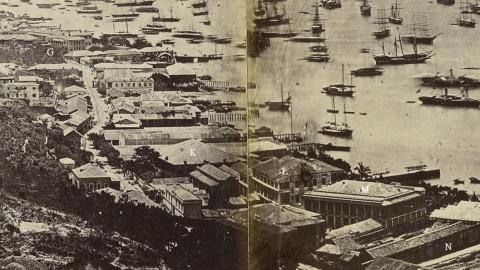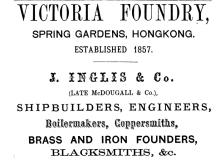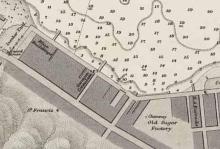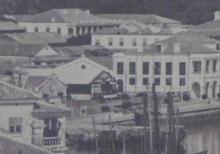Shipbuilding in Wanchai started in the mid-1840s already. On Marine Lot No. 31 the Emery & Frazer Co. started business and constructed a slipway. After many changes in ownership, in 1856 Ross & Perkins Co. expanded the shipyard into the adjoining Marine Lot No. 36. In 1868 it was known as the Victoria Foundry. In 1870, John Inglis took over the Victoria Foundry. (Source)
This area is probably shown on the photo below:
The Hong Kong Daily Press from 1880-06-01 refers:
The Victoria Foundry at Wanchi(!) has been bought and will be re-started by Messrs. Fenwick and Morrison. The former was for some years employed at the works and is now chief engineer of the Yangtszé; the latter was chief engineer of the Amoy, and was lately in business in Shanghai.
The company acted under the name of Fenwick & Morrison Co. In 1887, George Fenwick set up his own business Fenwick & Co. (Source),.
In David’s post “Wanchai's seafront in 1902” it is reported about Fenwick’s business on Marine Lots No. 31 and No. 36:
"[...] there had been a creek running through the lot from which ships were launched. Then the government closed the creek and the drawbridge at the Praya. This forced the company to stop building larger vessels, though small launches were still built and carted across the Praya to the sea".
The small basin and the bridge can be seen on the 1888 map shown below.
It existed in 1886 when it was mentioned in the Hong Kong Government Gazette from the 20th November, 1886:
"…macadamizing, &c., the Praya from Spring Garden Lane to Fenwick’s Bridge on a length of 645 feet”.
After the death of George Fenwick in 1896, the company was continued by W.G. Winterburn.
The construction of the tram in 1904 forced the company to move in 1905:
The Hong Kong Daily Press from 1904-09-23 refers:
GEO. FENWICK & CO., Ld
It is said that Messrs. Geo. Fenwick and CO., Ld., will hold an extraordinary meeting shortly to sanction the proposal to increase the capital of the company, which money, however, is not expected to be required before six to nine months have elapsed. It be remembered that the company recently acquired a convenient site for their works at North Point, having the prospect of being obliged to vacate their present promises. Their water frontage will shortly be taken away by the new reclamation scheme. The area of their new lot is about 215,000 sq. ft., with a deep water frontage of 400 ft. in length. To reclaim this site, work now proceeding, it is estimated that it will cost the company about $1 a square foot. It is hoped to dispose of the present premises for a good figure. The lease is held on a 999 years' tenure, and, being a marine lot, carries the right to the projected reclamation pertaining to the frontage. The directors of the company consider that it will be necessary to increase the capital to $450,000, an increase of $300,000.
Update 2024-05-30
In an advert in the the Chronicle for 1905 it is referred that
In order to cope with the increasing business it has now become necessary to transplant the entire works, there being no room for further extension on the Wanchai premises: an area of 5 acres has been purchased and the reclamation and construction of new workshops is being rapidly pushed forward.
The new site is situated at North Point near the Iron Pier of the Royal Dutch Petroleum Co, Ld.(which pier was erected by Geo. Fenwick & Co., Ld., a few years ago), and is conveniently reached by the Electric Tramway, rickshaw, or by launch.
The harbour frontage is 400 feet, with deep water for vessels of considerable tonnage to lie along- side whilst undergoing repairs. The Western side of the property forms a good shelter from typhoons and the refuge harbour of Causeway Bay is quite close.
This likely is on M.L. 285 which was reclaimed and finished in 1906. (PWR 1906)
The old premises in Wanchai were still in use as long as the company existed. Possibly the new shipyard at North Point never came into full operation - even in an advert from 1909 it still reads "in progress of reclamation". The invest in this new premises likely were to high and the other and bigger shipyards took over the shipbuilding market.
A last listing is in the Chronicle for 1911, the Chronicle for 1913 lists the company as being "in liquidation".



